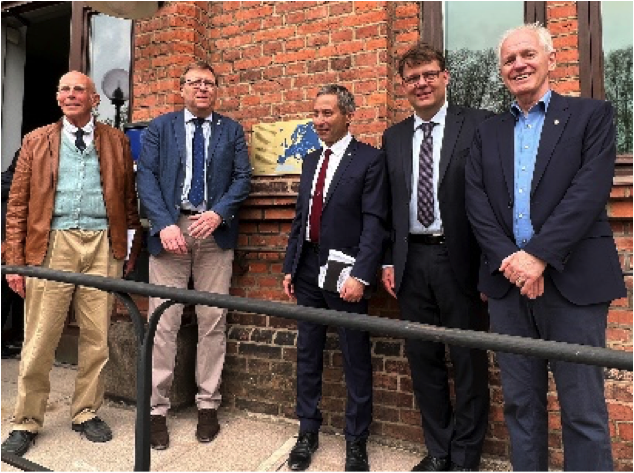Author: Sune Svanberg
On 10th May, 2022, the old Physics Department of Lund University,
Sweden, was inaugurated as an EPS Historic Site. The building, which is
located at Biskopsgatan 3, Lund, served the Lund physicists during the
years 1885 to 1950. It had two halls for instruments, an auditorium, 12
offices, a library and a workshop. The building then became the base for
classical studies (Classicum) until in 2009 after renovation became
the site of the interdisciplinary Pufendorf Institute of Advanced
Studies. The ceremony was actually planned for 26th May 2020, but had on
short notice to be moved forward due to the Covid-19 pandemic.
The
nomination as an EPS Historic Site is based on the work of Johannes
(Janne) Rydberg (1854-1919), who was active in analyzing atomic spectral
lines, which Bunsen and Kirchhoff around 1850 had found to be specific
for each species. Balmer had in 1885 found a formula to describe the
lines of hydrogen. Being an excellent mathematician, with a great
feeling for numbers, Rydberg found a more general formula, which also
worked well, e.g. for the alkali atoms. He presented his first results
in 1887 in a report to the Royal Swedish Academy of Sciences, and more
in detail in a presentation to the Mathematical-Physical Society in Lund
in 1888. The full account of his findings occurs in a scientific
article published in German in 1890 (Zeitschrift für Physikalische
Chemie). The most amazing aspect of this formula was that there occurred
a constant, which was the same for all elements and all spectral
series. In his early model for the atomic structure, Niels Bohr could in
1913 also give a theoretical value for the constant, which well agreed
with the experimental value found by Rydberg. The constant came to be
known as the Rydberg constant, and is presently determined to an
extremely high precision using laser spectroscopy. Rydberg´s name is
also associated with the much studied Rydberg atoms, which are very
highly excited atoms becoming accessible through laser spectroscopy, and
through the Rydberg-Ritz combination principle of atomic spectroscopy.
It can be noted that Manne Siegbahn (1886-1978) was also active in the building, making ground-breaking precision X-ray spectroscopy studies. Bengt Edlén
(1906-1993), who in 1941 solved the old problem of the origin of the
corona lines from the sun, was a further prominent Lund atomic
physicist.
The inauguration ceremony was organized and led by Sune
Svanberg, who had also made the site nomination. Stacey Ristinmaa
Sörensen, the Pufendorf Institute director, welcomed a large crowd of
fellow physicists assembled to celebrate, and Joachim Schnadt, chairman
of the Department of Physics, recalled the work by Rydberg. Mats
Helmfrid expressed his appreciation on behalf of the Lund City Council.
The chairman of the EPS selection committee for historic sites, Karl
Grandin, introduced the EPS programme together with the EPS president,
Luc Bergé, who also performed the solemn uncovering of the memorial
plaque, accompanied by a brass band.
A Rydberg Lecture, in a
series of named lectures sponsored by the Royal Academy of Science,
followed at the new Physics Department directly after the inauguration
ceremony. The speaker was Jun Ye, JILA, National Institute of Standards
and Technology and University of Colorado, who in his talk “Tick Atoms
in Unison” described how extremely accurate atomic clocks could be
influenced by the gravitational shift due to only one mm of vertical
clock movement.
A Rydberg dinner arranged with some 30 guests in
the recognized building, with speeches including by the Lund University
vice Chancellor, Erik Renström, concluded a memorable day.



The memorial plaque at the old Physics Department, Lund University, has
just been uncovered.
FLTR: Sune Svanberg, Lund Laser Centre,
Karl Grandin, Chair of the EPS Historic Sites Selection Committee,
Luc
Bergé, EPS President, Joachim Schnadt, Department of Physics, and Mats
Helmfrid, Lund City Council
Photos: Sune Svanberg & Katarina Svanberg